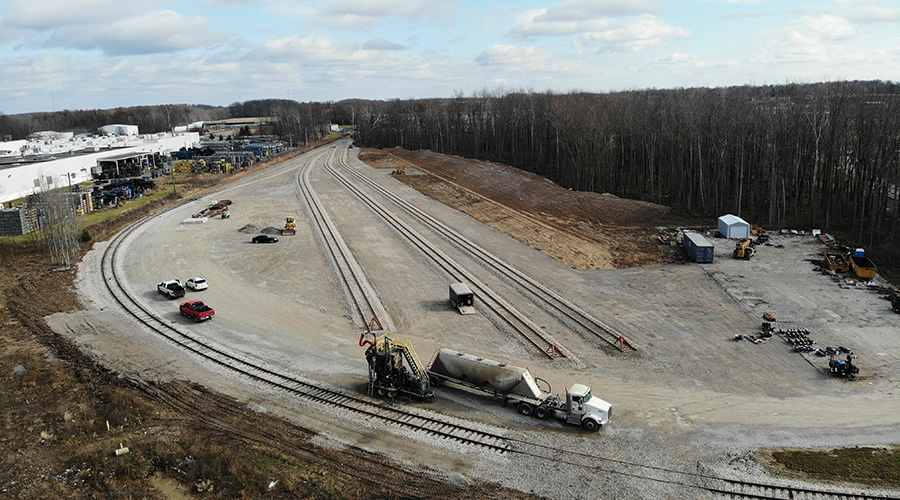Short lines win big in FY2021 round of CRISI grant awards
6/2/2022
By Julie Sneider, Senior Associate Editor
Of the more than $368 million in Consolidated Rail Infrastructure and Safety Improvements (CRISI) grant program funds announced today by the Federal Railroad Administration, at least $157.3 million will directly benefit short-line projects.
The federal dollars will be critical in helping short lines complete projects designed to rebuild vital assets, bolster safety, improve efficiency and better serve their customers, said American Short Line and Regional Railroad Association (ASLRRA) officials in a press release.
Short-line owners find CRISI a particularly attractive program because a railroad can apply directly for a grant, and many types of capital projects typical of a short line are eligible for funding under the program, ASLRRA officials said. Short lines can also apply for a grant through a partnership with another eligible organization, such as a state department of transportation or rail authority.
As the nation’s supply chain continues to face challenges, CRISI will fund projects that will strengthen weak spots in the country’s rail network, said ASLRRA President Chuck Baker.
 “In conversations with short line railroad owners and managers over the last few days, I’ve heard comments about how these CRISI grants will ‘transform the railroad.’” — Chuck Baker, president, ASLRRA ASLRRA
“In conversations with short line railroad owners and managers over the last few days, I’ve heard comments about how these CRISI grants will ‘transform the railroad.’” — Chuck Baker, president, ASLRRA ASLRRA “In conversations with short-line railroad owners and managers over the last few days, I’ve heard comments about how these CRISI grants will ‘transform the railroad’, ‘allow us to be good stewards of the railroad for the next generation,’ and ‘are a tremendous win for many stakeholders, most importantly our customers,’” Baker said in a prepared statement.
In this fiscal-year 2021 round of CRISI funding, 46 projects in 32 states and the District of Columbia qualified for grants. The FRA received more than 122 eligible applications requesting a total of $1.2 billion.
The Infrastructure Investment and Jobs Act, which President Joe Biden signed in November 2021, nearly tripled funding for CRISI to $1 billion a year for the next five years.
Among the largest short-line project awards was a $21.3 million grant to the Great Lakes Central Railroad in Michigan. The project calls for installing 4.25 miles of new rail, eliminating joints on an additional 41.25 mainline track miles, replacing or rehabilitating 11 bridges and culverts, and installing about 30,000 ties on mainline and siding track. The project is designed to improve safety and provide a more reliable transportation option for farms, factories and shippers, according to the ASLRRA.
Other short line-related awards include:
• $14,681,397, Colebrookdale Railroad and Eastern Berks Gateway Railroad, to rehabilitate 8.6 miles of track with 130-pound continuous welded rail (CWR) to handle 286,000-pound rail cars between Boyertown and Pottstown, Pennsylvania. The project will also rehabilitate or replace 14 bridges that are deteriorating, construct two rail-served transload yards and six new sidings.
• $10,991,971, Cimarron Valley Railroad, to replace 51,618 crossties; perform 3,577 flash-butt welds to rail; relay 3.7 miles of rail in curves; apply new ballast to 67 miles of track, and surface 85 miles of track in Kansas. The improvements will enable the rail to support biodiesel transport operations as well as local agricultural products, raise the allowable speed from 10 mph to 25 mph, and increase the weight capacity.
• $9,367,112, Kyle Railroad, to replace 23.5 track miles of 85-pound sectional rail with 115-pound continuous welded rail on the railroad’s Concordia Subdivision between Beloit and Yuma Junction, Kansas. The project also calls for replacing seven mainline turnouts with 115-pound No. 10 turnouts; a new 115-pound rail crossing in Beloit; complete ballast and surfacing; rebuilding three public grade crossings with concrete surface; and rebuilding 46 public and private grade crossings with timber plank surface, including underlying crosstie replacement. This project will increase the operating speed from 10 mph to 25 mph and support 286,000-pound rail cars.
• $8,697,910, West Michigan Railroad, to fund construction of and infrastructure improvements on 10 miles of rail line. The infrastructure improvements will upgrade portions of the line from 5 mph to up to 25 mph and ensure the line can continue to operate 286,000-pound rail cars.
• $8,383,761, Chicago, Fort Wayne & Eastern Railroad, to replace ballast and ties along a 54- mile segment of the mainline; and install 115-pound rail, ties, ballast and surfacing on a 14-mile segment of the Decatur Subdivision. Additionally, 43 at-grade crossing surfaces will be replaced with rubber seal/asphalt design for handling heavier loads, longevity of construction, and improved efficiency of travel at crossings.
• $8,300,000, Florida Gulf & Atlantic Railroad, to replace 70,000 ties, install 14,300 new ties, rehabilitate 11 sidings and repair 60 grade crossings between Jacksonville and Pensacola, Florida. The project may also include the acquisition of certain eligible rail equipment. The railroad will provide most of a 50% match, with contributions from three private-sector sources.
• $7,380,600, Central Kentucky Lines Railroad, to fund three improvements between Frankfurt and Lexington, Kentucky. The project calls for building a new freight rail-to-truck transload facility near Frankfort; rehabilitating track on the mainline between Frankfort and Lexington; and improving an existing main yard and transload facility in Lexington.
• $7,173,452, Iowa Northern Railway, to install 27.3 miles of CWR across the Manly Subdivision and the Cedar Rapids Subdivision in northeastern Iowa. This project will enable the track to handle train speeds up to 40 mph. The railroad will provide a 50% match
• $6,868,768, Wheeling & Lake Erie Railway, to construct a new connecting track and extension track in the Spencer Yard to eliminate switching movements and allow trains to directly access the yard from two rail subdivisions in Ohio. When completed, the project will eliminate a number of reversing movements for trains and expand overall capacity.
• $6,704,544, Red River Valley & Western Railroad, to replace 14.5 miles of old jointed rail with CWR between Independence and Oakes, North Dakota.
• $6,317,982, Nebraska Central Railroad, to complete the preliminary engineering, environmental clearance, final design and construction of four rail sidings, including through three grade crossings on the line in eastern Nebraska. These improvements will help to meet increased rail demand, alleviate congestion, increase the rail network's resiliency, and provide rail access to non-rail served industries.
• $6,190,136, Heart of Georgia Railroad, to replace 18 miles of rail and 2,750 crossties; make associated surface and ballast improvements; and install an OWLS Diamond switch as well as 10 turnouts between Preston and Cordele, Georgia. The improvements will accommodate 286,000-pound loads and help eliminate slow-orders along 51 miles of the rail lines that connect at the Cordele Inland Port.
• $6,067,200, Central Railroad of Indiana (CIND), to make safety improvements to four crossings on CSX and CIND. The project includes new signal equipment that meets or exceeds current safety standards, which will improve safety for all road users, especially hazmat-carrying trucks that queue up on the rail line due to traffic signal at a nearby intersection.
• $5,569,373, Port of Little Rock in Arkansas, to help the inland port railroad increase capacity and reduce fuel use. The project calls for adding 11,215 feet of track, constructing an engine maintenance facility and rooms for training, safety, tools, equipment and other storage.
• $4,962,110, Alabama & Tennessee River Railway, to make improvements between Birmingham and Guntersville. Improvements include upgrading siding and wye tracks that can handle increased traffic; eliminating switching across State Road 144; rehabilitating the SR-144 grade crossing surface; reactivating rockslide warning signals to allow for 25 mph train speeds between Birmingham and Ragland; and repair nine bridge structures to ensure continued 286,000-pound capacity.
• $3,144,277, Alaska Railroad Corp. (ARRC), to replace an aging bridge on the main rail route between Anchorage and Fairbanks, Alaska, where it crosses Little Goldstream Creek. The project will allow ARRC to replace the aging 62-foot, single-span through girder bridge with a 75-foot, single-span deck plate girder bridge. The new structure will feature a foundation and bridge design that accounts for the changing arctic climate and allows for 286,000-pound rail cars.
• $2,950,000, Georgia Southwestern Railroad, to replace 9 miles of 100-pound jointed rail with 115-pound rail, and upgrade railroad bridges along 65 miles between Lynn and Cuthbert, Georgia. The aim: improve system reliability, efficiency and safety by maintaining a state of good repair to prevent closures and derailments, and continue supporting 286,000-pound loads and Class 2 track status (speeds up to 25 mph) in southwestern Georgia.
• $2,931,122, New York, Susquehanna and Western Railway, for the environmental review, final design and installation of 6.9 miles of CWR, new rail ties, ballast/surfacing, and four new switches on the rail line in Onondaga and Cortland counties in New York.
• $2,618,173, Elkhart and Western Railroad, to relocate interchange track, upgrade the 9-mile Elkhart Branch line to Class 1 track safety standards, expand rail siding capacity and replace three grade crossing surfaces in Elkhart, Indiana. The project will relocate the interchange used by EWR and Norfolk Southern Railway by moving it out of the city center and into an industrial area.
• $1,840,000, Gettysburg and Northern Railroad, to rehabilitate 24 miles of the mainline in Adams and Cumberland County, Pennsylvania. The project will improve the track to Class 2 safety standards and operating speeds, construct a new runaround track adjacent to existing track, upgrade 16 crossings warning devices to LED signals, replace wigwag warning circuitry at two grade crossings and repair seven failed or failing culverts.
• $1,769,767, Burlington Shortline Railroad, to replace two bridges on the rail line in Quincy, Illinois. The two bridges, Ghost Hollow Creek and Curtis Creek, are 100 years old and replacing them with steel and concrete structures would ensure 286,000-pound freight service can continue.
• $1,617,824, Appalachian and Ohio Railroad, to make safety improvements along a 42-mile rail corridor between Grafton and Buckhannon, West Virginia. The project will replace the antiquated traffic control system and install a new and modern broken-rail detection system on the entire signaled section of the rail line.
• $1,478,000, Twin Cities & Western Railroad, to make improvements to 12.2 miles of track between Glencoe and Plano, Minnesota. The project calls for performing rail joint elimination via flash-butt welding to convert the existing infrastructure to CWR.


